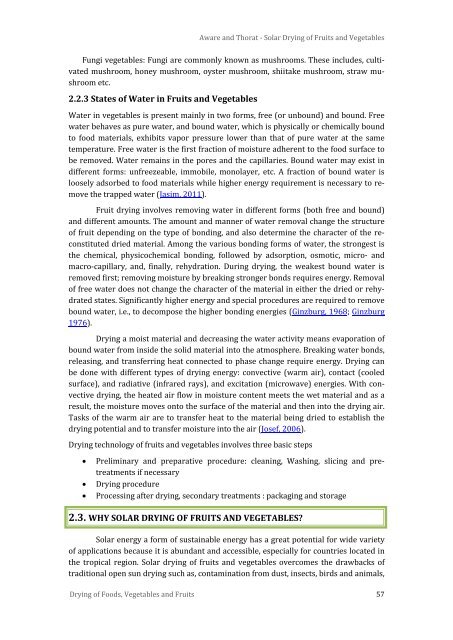Solar Drying: Fundamentals,Applications and Innovations - National ...
Solar Drying: Fundamentals,Applications and Innovations - National ...
Solar Drying: Fundamentals,Applications and Innovations - National ...
Create successful ePaper yourself
Turn your PDF publications into a flip-book with our unique Google optimized e-Paper software.
Aware <strong>and</strong> Thorat - <strong>Solar</strong> <strong>Drying</strong> of Fruits <strong>and</strong> Vegetables<br />
Fungi vegetables: Fungi are commonly known as mushrooms. These includes, cultivated<br />
mushroom, honey mushroom, oyster mushroom, shiitake mushroom, straw mushroom<br />
etc.<br />
2.2.3 States of Water in Fruits <strong>and</strong> Vegetables<br />
Water in vegetables is present mainly in two forms, free (or unbound) <strong>and</strong> bound. Free<br />
water behaves as pure water, <strong>and</strong> bound water, which is physically or chemically bound<br />
to food materials, exhibits vapor pressure lower than that of pure water at the same<br />
temperature. Free water is the first fraction of moisture adherent to the food surface to<br />
be removed. Water remains in the pores <strong>and</strong> the capillaries. Bound water may exist in<br />
different forms: unfreezeable, immobile, monolayer, etc. A fraction of bound water is<br />
loosely adsorbed to food materials while higher energy requirement is necessary to remove<br />
the trapped water (Jasim, 2011).<br />
Fruit drying involves removing water in different forms (both free <strong>and</strong> bound)<br />
<strong>and</strong> different amounts. The amount <strong>and</strong> manner of water removal change the structure<br />
of fruit depending on the type of bonding, <strong>and</strong> also determine the character of the reconstituted<br />
dried material. Among the various bonding forms of water, the strongest is<br />
the chemical, physicochemical bonding, followed by adsorption, osmotic, micro- <strong>and</strong><br />
macro-capillary, <strong>and</strong>, finally, rehydration. During drying, the weakest bound water is<br />
removed first; removing moisture by breaking stronger bonds requires energy. Removal<br />
of free water does not change the character of the material in either the dried or rehydrated<br />
states. Significantly higher energy <strong>and</strong> special procedures are required to remove<br />
bound water, i.e., to decompose the higher bonding energies (Ginzburg, 1968; Ginzburg<br />
1976).<br />
<strong>Drying</strong> a moist material <strong>and</strong> decreasing the water activity means evaporation of<br />
bound water from inside the solid material into the atmosphere. Breaking water bonds,<br />
releasing, <strong>and</strong> transferring heat connected to phase change require energy. <strong>Drying</strong> can<br />
be done with different types of drying energy: convective (warm air), contact (cooled<br />
surface), <strong>and</strong> radiative (infrared rays), <strong>and</strong> excitation (microwave) energies. With convective<br />
drying, the heated air flow in moisture content meets the wet material <strong>and</strong> as a<br />
result, the moisture moves onto the surface of the material <strong>and</strong> then into the drying air.<br />
Tasks of the warm air are to transfer heat to the material being dried to establish the<br />
drying potential <strong>and</strong> to transfer moisture into the air (Josef, 2006).<br />
<strong>Drying</strong> technology of fruits <strong>and</strong> vegetables involves three basic steps<br />
• Preliminary <strong>and</strong> preparative procedure: cleaning, Washing, slicing <strong>and</strong> pretreatments<br />
if necessary<br />
• <strong>Drying</strong> procedure<br />
• Processing after drying, secondary treatments : packaging <strong>and</strong> storage<br />
2.3. WHY SOLAR DRYING OF FRUITS AND VEGETABLES<br />
<strong>Solar</strong> energy a form of sustainable energy has a great potential for wide variety<br />
of applications because it is abundant <strong>and</strong> accessible, especially for countries located in<br />
the tropical region. <strong>Solar</strong> drying of fruits <strong>and</strong> vegetables overcomes the drawbacks of<br />
traditional open sun drying such as, contamination from dust, insects, birds <strong>and</strong> animals,<br />
<strong>Drying</strong> of Foods, Vegetables <strong>and</strong> Fruits 57

















